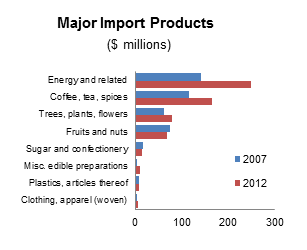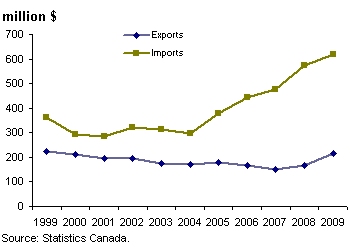Introduction
For the last six decades, Canada and Columbia have had comprehensive political relations. Colombia has an embassy in Ottawa while Canada has its embassy in Bogota. The countries enjoy full-fledged bilateral relations. These include intimate economic ties resulting in free trade agreements. These agreements have enabled Canada to import coffee from Colombia.
Main Body
Coffee is among the main agricultural products globally. Many people all over the world irrespective of age, gender, class, religious affiliations, or race prefer it to other beverages. In this respect, coffee is a principal source of foreign earning after oil for majority of developing countries, ensuring the sustenance of their economies. Simultaneously, it impacts the global economy considering that it is among the key primary products in global trade. Coffee, therefore, supports the livelihood of the cultivators. Unfortunately, for the producers, the product’s price is extremely volatile because of natural causes, supply and demand variances.
Consequently, countries that produce the commodity founded the Association of Coffee Producing Country (ACPC) to augment the International Coffee Organization. The organizations facilitate the maintenance of a stable coffee market. Despite this move, there exist numerous hurdles that producers require overcoming. Colombia is the second largest coffee producer (Joho, 2014). This study explores different aspects of coffee produced and exported by Columbia. It pays special attention to coffee trade between Colombia and Canada.
General Information
Colombian Coffee History
Colombia has a magnificent coffee producing history. It mainly grows Arabica coffee, favored by the country’s distinctive geography. The variety is regarded the highest quality bean globally. The location and the weather are ideal for the production of a tasty, high quality beverage. The country’s outstanding growing environment coupled with vigorous marketing campaigns has seen the coffee gain attention in the international coffee market. Established in 1950s, the National Federation of Coffee Growers (FNC) has worked relentlessly towards this end.
Geographical conditions
The 100 percent washed Arabica variety grown in the country requires particular climatic conditions. The variety initially grew in the mountains of East Africa where it continues to thrive including Kenya, Ethiopia, Uganda, and Tanzania. The growth of the variety also requires specific soils, warmth, rain, and altitude above sea level. The perfect conditions for the growth of the variety in the country are found between 1200-1800 meters above seal level. In these areas, the temperature ranges between 17 and 23 degrees centigrade. The amount of rainfall ranges at 2,000 millimeters annually. The country is bisected by the Andes Mountains. The mountains divide into 3 parallel mountain ranges, running from south to north.
Colombia is geographically small. It prides itself with two of South Americas 5 biodiversity hotspots. These include the Tumbes-Choco occupying the entire coast and the Tropical Andes covering the entire mountain ranges. There are about half a million farms in these regions. Majority of the farms are small scale holdings of five hectares or less. They are spread across the zonas cafeterias (tropical Andes) containing one sixth of earth’s flora species (Equal Exchange, 2014).
Specific Information
Amount of trade (Import/Exports)
Colombia coffee is typically imported by the US, Canada, Germany, Italy and Japan. The proximity of Colombia to Canada makes Colombia a favorable trade partner. The countries have also established trade agreements that create bilateral trade agreements in a variety of merchandise trade.
Relative Percentages
For example in 2012, the merchandise trade between the countries was $1.5 billion. The export to Colombia was $828 million while the import from Colombia was $664.5 million. Considering the economic discrepancies between the two countries, the trade was fairly balanced as Canada is a developed economy while Colombia is a developing economy. The value of Colombia’s export to Canada grew at an average rate of 7.2 percent between 2007 and 2012, contrasting the global increase rate of 2.6 percent (Industry Canada, 2014).

On the products front, the value of Canada’s exports of manufactured products in 2012 was 57.3 percent. The other percentage accounted for resource-based products. Notably, the percentage of exports in manufactured goods to Colombia has been decreasing from an all-time-high of 67.3 percent in 2007.
Goods most traded
The highest valued exports by Canada to Colombia during the fiscal year 2012 were wheat ($102 million), vegetables ($50 million), potash ($26 million), and newsprint ($29 million). In the same year, Colombia conducted substantial export trade with Canada. Resource-based commodity accounted for 80.2 percent of Canada’s imports from Colombia. Manufactured commodity accounted for the rest 19.8 percent. These figures reflect significant changes since 2007. In 2007, resource-based commodity accounted for 73.5 percent while manufactured goods accounted for 26.5 percent for Canadian imports from Colombia.



The most valued exports by Colombia to Canada include coffee, coal, and crude oil in 2012. The products accounted for 58.4 percent of the value of Colombia’s export to Canada. The value of these products increased between 2007 and 2012. Coffee increased from $114 million to $166 million. Coal increased from $101 million. There was a record set by coal which had zero value in 2007. In 2012, the value of coal export to Canada was $107 million (Industry Canada, 2014).
It is imperative to acknowledge that Canada had a substantial trade discrepancy with Colombia. This occurred in the commodity classes of metals, mines, and energy. In all the other classes during the year 2012, Canada had a trade surplus with Colombia.
Socioeconomic indicators
Columbia has a population of 48.33 million according to a report released by the World Bank in 2013. The figure places the country at position 29 on world ranking. The Gross National Income is valued at $7,560 for the year 2013. The Colombian government has made tremendous steps towards the creation of employment opportunities for its populace. In 2002, the unemployment rate was at 17.9 percent. It has continuously reduced with an all-time-low achieved in 2013 at 7.8 percent. Currently, unemployment rate is at 8.9 percent (Trading Economics, 2014).

Colombia’s Gross Domestic Product (GDP) is estimated at $388 billion. The country’s economy has been growing fast within the last two decades. It is currently ranked at position 35 globally in terms of the size of the economy.
Conclusion
Consumers globally are increasingly becoming aware of the significance of origin when selecting coffee. They are increasingly requesting for Colombian coffee. The result is high demand for Colombian coffee globally. The Canadian population is among the loyal consumers of Colombian coffee. This has led to strengthening of bilateral trade relations between Canada and Columbia that extend beyond coffee trade. The trade conducted between Columbia and Canada has led to the fast growth of the Colombian economy. Apparently, it is imperative for countries to enter into bilateral and multilateral trade agreements to promote the globalization of trade.
References
Equal Exchange. (2014). History of coffee in Colombia. Web.
Industry Canada. (2014). Trade data online. Web.
Joho, Z. (2014). Coffee market and Colombia. Web.
Trading Economics. (2014). Colombia unemployment rate. Web.